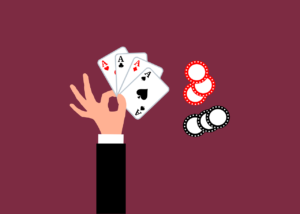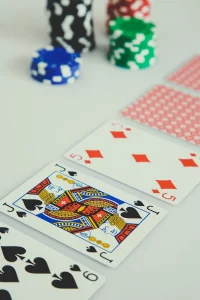Mastering Poker Table Talk: The Art of Verbal and Non-Verbal Communication is a crucial skill for any serious poker player. The way you communicate with your opponents can have a significant impact on the outcome of the game. Knowing how to read your opponents’ body language and verbal cues can give you an edge at the table. In this article, we will explore the importance of mastering poker table talk and provide tips on how to improve your communication skills.
The Importance of Verbal Communication at the Poker Table
First and foremost, verbal communication is essential in poker because it allows you to gather information about your opponents. By listening to what they say and how they say it, you can gain valuable insights into their thought processes, emotions, and tendencies. For example, if an opponent is talking a lot and seems nervous, they may be bluffing. On the other hand, if they’re quiet and reserved, they may have a strong hand.
Verbal communication can also be used to mislead your opponents. By saying one thing and doing another, you can create confusion and uncertainty in their minds. For example, if you have a weak hand, you might say something like “I’m all in” to make your opponents think you have a strong hand. This can cause them to fold, giving you the pot.
However, it’s important to remember that verbal communication is a two-way street. Your opponents are also listening to what you say and how you say it. Therefore, it’s crucial to be mindful of your own verbal cues and to use them strategically. For example, if you have a strong hand, you might speak confidently and assertively to intimidate your opponents.
Non-verbal communication is also an essential aspect of poker. Your body language, facial expressions, and gestures can reveal a lot about your hand and your intentions. For example, if you’re nervous, you might fidget or avoid eye contact. If you have a strong hand, you might sit up straight and make direct eye contact with your opponents.
However, it’s important to be aware of your non-verbal cues and to avoid giving away too much information. For example, if you have a weak hand, you might try to act confident to bluff your opponents. But if you overdo it, you might give away your bluff and lose the pot.
In addition to verbal and non-verbal communication, timing is also crucial in poker. Knowing when to speak and when to stay silent can be the difference between winning and losing. For example, if you have a strong hand, you might wait until the last minute to make a bet, hoping to entice your opponents to raise the stakes. On the other hand, if you have a weak hand, you might fold early to avoid losing more money.
In conclusion, mastering poker table talk is an essential skill for any serious poker player. Verbal and non-verbal communication can provide valuable insights into your opponents’ hands and intentions, while also allowing you to mislead and intimidate them. However, it’s important to be mindful of your own verbal and non-verbal cues and to use them strategically. With practice and patience, you can become a master of poker table talk and increase your chances of success at the poker table.
Mastering Non-Verbal Cues in Poker: What Your Body Language Says
It is essential to understand that your body language can give away a lot about your hand. For example, if you have a strong hand, you may sit up straighter, breathe more deeply, or even smile. Conversely, if you have a weak hand, you may slouch, fidget, or avoid eye contact. These subtle cues can be picked up by observant opponents, who can use them to make informed decisions about their own play.
To avoid giving away too much information, it is crucial to maintain a consistent demeanor throughout the game. This means controlling your body language, regardless of the strength of your hand. One way to do this is to adopt a neutral posture and facial expression. This can help to mask any nervousness or excitement you may be feeling, and prevent your opponents from reading too much into your behavior.
Another important aspect of non-verbal communication in poker is timing. The timing of your actions can reveal a lot about your hand and your intentions. For example, if you take a long time to make a bet, it may indicate that you have a weak hand and are trying to bluff your opponents. Conversely, if you make a quick bet, it may indicate that you have a strong hand and are trying to intimidate your opponents.
To use timing to your advantage, it is important to be aware of your opponents’ behavior. If you notice that they are taking a long time to make decisions, it may indicate that they are unsure of their hand or are trying to bluff you. In this case, you may want to make a quick bet to put pressure on them and force them to make a decision.
Finally, it is important to be aware of your own behavior and how it may be perceived by your opponents. This means paying attention to your own body language, as well as the words you use and the tone of your voice. For example, if you are overly aggressive or confrontational, it may make your opponents feel uncomfortable and less likely to engage with you. On the other hand, if you are friendly and approachable, it may make your opponents more willing to engage with you and share information.
In conclusion, non-verbal communication is a crucial aspect of poker that can give you a significant edge over your opponents. By understanding the nuances of body language and timing, you can control the information you reveal and use it to your advantage. Remember to maintain a consistent demeanor, be aware of your opponents’ behavior, and pay attention to your own behavior. With practice and patience, you can master the art of non-verbal communication in poker and become a more successful player.
The Psychology Behind Effective Poker Table Talk
The first thing to understand is that poker is a social game. Players interact with each other throughout the game, and the way they communicate can reveal a lot about their hand, their strategy, and their mindset. Effective poker table talk involves both verbal and non-verbal communication, and mastering both can help you gain valuable information about your opponents.
Verbal communication at the poker table includes everything from small talk to strategic conversations. Small talk can help you build rapport with your opponents and make them more likely to reveal information about their hand or strategy. Strategic conversations, on the other hand, can help you gather information about your opponents’ thought processes and decision-making.
Non-verbal communication at the poker table includes everything from facial expressions to body language. Players often use non-verbal cues to bluff or deceive their opponents, but they can also reveal valuable information about their hand or strategy. For example, a player who is nervous or anxious may be holding a weak hand, while a player who is relaxed and confident may be holding a strong hand.
Understanding the psychology behind effective poker table talk requires a deep understanding of human behavior and communication. One of the most important things to remember is that people are often more honest and open when they feel comfortable and relaxed. By building rapport with your opponents through small talk and friendly conversation, you can make them more likely to reveal information about their hand or strategy.
Another important aspect of effective poker table talk is the ability to read your opponents’ non-verbal cues. This requires a keen eye for detail and an understanding of body language and facial expressions. For example, a player who is avoiding eye contact or fidgeting may be nervous or anxious, while a player who is making direct eye contact and sitting up straight may be confident and holding a strong hand.
It’s also important to remember that effective poker table talk is a two-way street. While you are trying to gather information about your opponents, they are also trying to gather information about you. This means that you need to be aware of your own verbal and non-verbal cues and make sure that you are not giving away any information about your hand or strategy.
In conclusion, mastering the art of verbal and non-verbal communication at the poker table can give you a significant advantage over your opponents. By understanding the psychology behind effective poker table talk, you can build rapport with your opponents, gather valuable information about their hand and strategy, and avoid giving away any information about your own hand or strategy. So the next time you sit down at the poker table, remember to pay attention to both your own communication and your opponents’ communication, and use it to your advantage.
How to Use Table Talk to Your Advantage in Poker
Table talk refers to the verbal and non-verbal communication that takes place at the poker table. It includes everything from the words you say to the way you hold your cards. Understanding how to use table talk to your advantage can help you read your opponents, control the pace of the game, and influence the outcome of hands.
One of the most important aspects of table talk is reading your opponents. Paying attention to their words, tone, and body language can give you valuable information about their hand and their mindset. For example, if an opponent is talking a lot and seems nervous, they may be bluffing. On the other hand, if they are quiet and focused, they may have a strong hand.
Another way to use table talk to your advantage is to control the pace of the game. If you’re in a hurry to play a hand, you can speed up the game by talking quickly and making quick decisions. Conversely, if you want to slow down the game and give yourself more time to think, you can talk more slowly and take your time making decisions.
Table talk can also be used to influence the outcome of hands. For example, if you have a weak hand but want to bluff your opponents into folding, you can use confident and assertive language to make them think you have a strong hand. Similarly, if you have a strong hand and want to encourage your opponents to bet more, you can use hesitant and uncertain language to make them think you’re unsure of your hand.
Non-verbal communication is also an important aspect of table talk. The way you hold your cards, your posture, and your facial expressions can all give away information about your hand and your mindset. For example, if you’re holding your cards tightly and leaning forward, you may have a strong hand. If you’re slouching and looking around the table, you may be unsure of your hand.
One of the keys to mastering table talk is to be aware of your own communication style and how it may be perceived by others. For example, if you tend to talk a lot when you’re nervous, you may be giving away information about your hand. Similarly, if you tend to fidget or look around the table when you’re unsure of your hand, your opponents may pick up on this and use it to their advantage.
In addition to being aware of your own communication style, it’s also important to be aware of the communication styles of your opponents. Paying attention to their words, tone, and body language can give you valuable information about their hand and their mindset. For example, if an opponent is talking a lot and seems nervous, they may be bluffing. On the other hand, if they are quiet and focused, they may have a strong hand.
In conclusion, mastering the art of table talk can give you a significant advantage in poker. Understanding how to read your opponents, control the pace of the game, and influence the outcome of hands can help you win more often and become a more successful player. By paying attention to both verbal and non-verbal communication, and being aware of your own communication style, you can become a master of table talk and take your poker game to the next level.
Common Mistakes to Avoid When Communicating at the Poker Table
The first mistake that many players make is talking too much. While it’s important to be friendly and engage in conversation with your opponents, you don’t want to give away too much information. Talking too much can reveal your hand strength, your strategy, and your emotions. It can also distract you from paying attention to the game and making the best decisions. So, be mindful of how much you’re talking and what you’re saying.
The second mistake is being too aggressive or confrontational. Poker can be a competitive game, but it’s important to maintain a level of respect and sportsmanship. Being overly aggressive or confrontational can create a hostile environment and make it difficult to focus on the game. It can also make other players less likely to want to play with you in the future. So, be assertive but not aggressive, and always treat your opponents with respect.
The third mistake is failing to read your opponents’ body language. Non-verbal communication is just as important as verbal communication in poker. Your opponents’ body language can reveal a lot about their hand strength, their emotions, and their strategy. So, pay attention to their facial expressions, their posture, and their gestures. This can help you make better decisions and avoid being bluffed.
The fourth mistake is being too predictable. If you always act the same way, your opponents will be able to read you easily and take advantage of your weaknesses. So, mix up your play style and your communication style. Use different tones of voice, facial expressions, and gestures to keep your opponents guessing. This can make it harder for them to read you and give you an edge in the game.
The fifth mistake is failing to adapt to your opponents’ communication style. Every player has a unique communication style, and it’s important to adapt to it. If your opponent is talkative, engage in conversation with them. If they’re quiet, don’t try to force them to talk. If they’re aggressive, be assertive but not confrontational. If they’re passive, take advantage of their weakness. By adapting to your opponents’ communication style, you can build rapport with them and gain valuable information.
In conclusion, mastering poker table talk is an essential skill for any serious poker player. By avoiding these common mistakes and practicing effective communication, you can improve your game and increase your chances of winning. Remember to be mindful of how much you’re talking, be respectful and sportsmanlike, read your opponents’ body language, mix up your play style, and adapt to your opponents’ communication style. With these tips in mind, you’ll be well on your way to becoming a master of poker table talk. Mastering Poker Table Talk is an essential skill for any serious poker player. Verbal and non-verbal communication can provide valuable information about opponents’ hands and intentions, and can also be used to manipulate and deceive other players. By understanding the nuances of poker table talk, players can gain a significant edge in the game and increase their chances of success.




